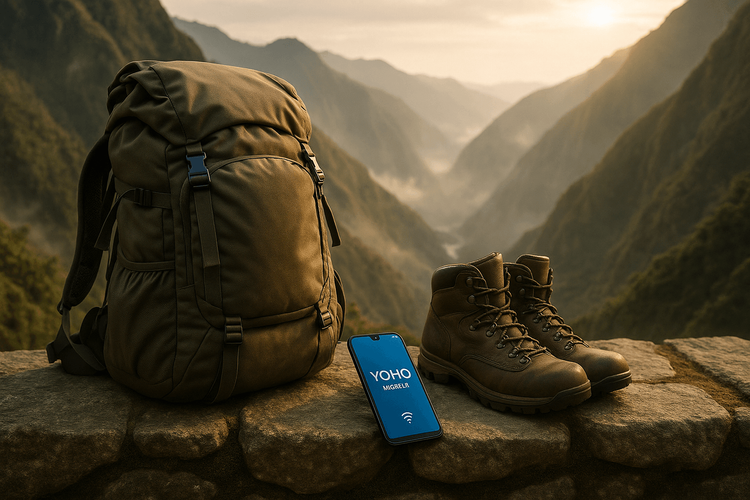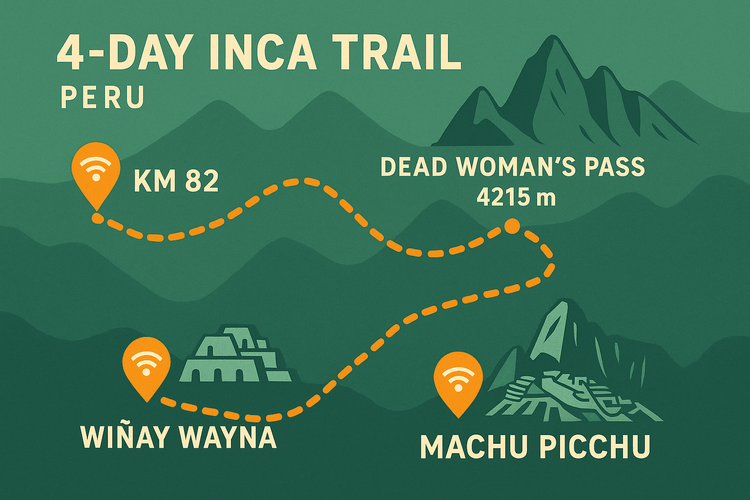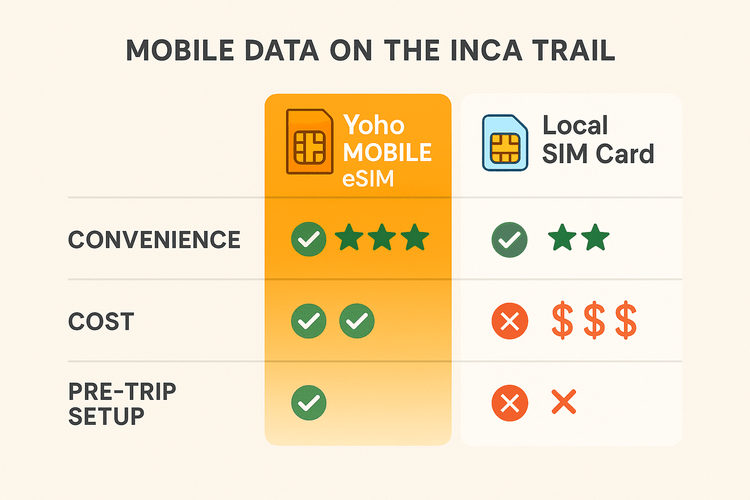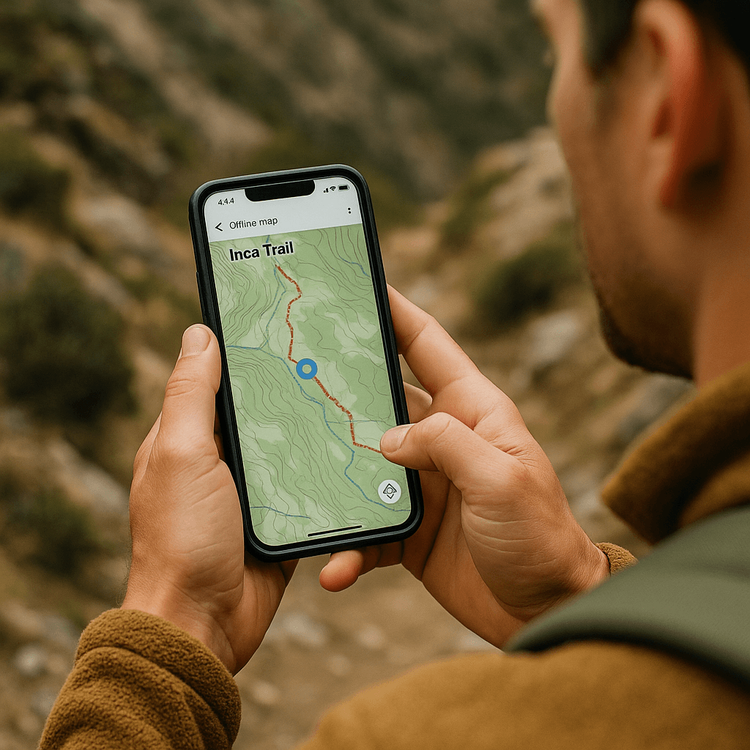Пътеводител за свързаност по Пътеката на инките: Използване на eSIM в Перу (2025)
Bruce Li•Sep 17, 2025
Пътеката на инките е пътуване назад във времето, възможност да се откъснете от модерния свят и да вървите по стъпките на древни цивилизации. Но в епохата на дигиталните карти и незабавната комуникация, пълното прекъсване на връзката невинаги е практично или безопасно. Този пътеводител изследва реалността на свързаността по Пътеката на инките и обяснява защо подготовката с eSIM за Перу е най-умният ход за всеки съвременен турист.
Преди да опаковате туристическите си обувки, уверете се, че дигиталната ви връзка е уредена. Разгледайте гъвкавите eSIM планове на Yoho Mobile за Перу, за да сте подготвени за вашето приключение.
Защо все пак се нуждаете от свързаност по Пътеката на инките
Макар целта да е да се потопите в природата, наличието на връзка за данни в ключови моменти може да превърне вашето преживяване от стресиращо в безпроблемно. Ето защо това е важно:
- Безопасност при отдалечени преходи: Пътеката е отдалечена и предизвикателна. Кратък сигнал може да бъде спасителен, позволявайки ви да изпратите бързо съобщение „всичко е наред“ на семейството, да проверите за спешни метеорологични предупреждения от националната метеорологична служба на Перу или да се свържете със спешните служби в критична ситуация.
- Навигация и логистика: Въпреки че ще имате водач, наличието на офлайн GPS карта осигурява спокойствие. След като стигнете до Агуас Калиентес, връзката е жизненоважна за потвърждаване на хотелски резервации, проверка на разписанията на влаковете обратно до Куско или намиране на място за празнична вечеря.
- Споделяне на момента: Няма да предавате на живо прехода си, но намирането на място със сигнал, за да качите една спираща дъха снимка на Андите, може да бъде чудесен начин да споделите пътуването си с близките у дома.

Реалността на мобилния сигнал по Пътеката на инките
Нека изясним очакванията: за около 90% от Класическата 4-дневна Пътека на инките вие ще бъдете без мобилен сигнал. Планинският терен блокира приема почти напълно. Въпреки това, свързаността не е напълно несъществуваща. Ето разбивка на това, което можете да очаквате:
- Начална точка (км 82): Тук вероятно ще имате приличен сигнал, за да изпратите последни съобщения, преди да започнете.
- Високи проходи (напр. Проходът на мъртвата жена): Много рядко може да уловите мимолетен, слаб сигнал в най-високите точки. Не разчитайте на това, но е възможност.
- Къмпинг Wiñay Wayna: Някои туристи съобщават за възможност за свързване към платена, бавна Wi-Fi мрежа тук. Тя е ненадеждна и често претоварена.
- Агуас Калиентес: Градът в основата на Мачу Пикчу има надеждно 4G покритие от местни доставчици като Claro и Movistar.
- Мачу Пикчу: Ще намерите сигнал близо до главния вход и някои от по-високите точки на цитаделата, идеално за онзи триумфален пост в социалните мрежи.
Една eSIM, която се свързва с множество местни мрежи, ви дава най-добрия шанс да уловите сигнал, когато такъв стане наличен.

Вашият най-добър вариант за свързаност: Yoho Mobile eSIM за Перу
Когато става въпрос за поддържане на връзка в Перу, имате три основни избора. Една eSIM обаче предлага перфектната комбинация от удобство и контрол за пътуване като Пътеката на инките.
Yoho Mobile eSIM: Умният избор
eSIM (вградена SIM) е дигитална SIM карта, която можете да инсталирате на телефона си, без да се нуждаете от физическа карта. За пътуване до Перу това променя правилата на играта.
- Активирайте от дома: Закупете и инсталирайте своя план за данни за Перу, преди дори да сте тръгнали. Ще бъдете свързани в момента, в който кацнете в Куско, без да е необходимо да търсите магазин за SIM карти.
- Максимална гъвкавост: Изберете точното количество данни, от което се нуждаете. Няма да използвате много по пътеката, така че по-малък план е идеален за дните преди и след прехода.
- Никога не губете връзка с Yoho Care: Ами ако използвате повече данни от планираното в Куско? С Yoho Care никога няма да останете без връзка. Тя осигурява резервна мрежа, за да гарантира, че винаги можете да изпратите съобщение или да проверите карта, предлагайки безценно спокойствие.
Други опции
- Местна SIM карта: Можете да си купите такава в Куско, но това включва намиране на магазин, справяне с езикови бариери и представяне на паспорт. Това е неудобство след дълъг полет.
- Международен роуминг: Това е най-скъпият вариант с голяма разлика. Натрупването на такси за роуминг за малкото количество свързаност, което ще получите, не е разумна стратегия. Според GSMA разходите за роуминг могат да бъдат непредсказуеми.

Как да увеличите максимално живота на батерията и данните по пътеката
Вашият телефон е инструмент, но е безполезен с изтощена батерия. Ето как да управлявате ресурсите си за най-доброто преживяване по Пътеката на инките.
- Изтеглете офлайн карти: Преди да напуснете Wi-Fi мрежата в Куско, изтеглете целия регион в Google Maps или приложение като Maps.me. Това ви позволява да използвате GPS-а на телефона си за навигация, без да се нуждаете от данни.
- Носете си външна батерия (Power Bank): Това не подлежи на обсъждане. Надеждна външна батерия с голям капацитет е една от най-важните части от съвременната туристическа екипировка.
- Включете самолетен режим: През по-голямата част от прехода дръжте телефона си в самолетен режим. Това драстично ще запази батерията ви, тъй като тя няма да търси постоянно несъществуващ сигнал.
- Управлявайте потреблението си на данни: Включвайте мобилните си данни само в конкретните точки, известни с наличието на обхват. Изтеглете каквото ви трябва, изпратете съобщенията си, след което се върнете в самолетен режим.
Преди да тръгнете, уверете се, че устройството ви е готово, като проверите официалния списък със съвместими с eSIM устройства.

Често задавани въпроси (ЧЗВ)
В1: Как мога да имам интернет по Пътеката на инките?
Достъпът до интернет е изключително ограничен. През по-голямата част от прехода няма да имате сигнал. Най-добрата стратегия е да се подготвите с eSIM за Перу от Yoho Mobile, за да се свързвате автоматично на малкото места, където има наличен сигнал, като например началната точка на пътеката и близо до Мачу Пикчу.
В2: Ще работи ли телефонът ми в Мачу Пикчу?
Да, би трябвало да имате надежден сигнал за мобилни данни на входа на Мачу Пикчу и в близкия град Агуас Калиентес. Това е идеалното място да използвате данните от вашата eSIM, за да се свържете със семейството си или да качите снимки.
В3: Лесно ли се настройва Yoho Mobile eSIM за Перу за моя преход?
Абсолютно. Можете да я закупите и инсталирате от вкъщи за минути. За потребителите на iOS това е прост процес на инсталация с едно кликване след покупката. Това означава, че кацате в Перу с готови за използване данни, избягвайки всякакъв стрес след полета.
В4: Кой е най-добрият начин за използване на офлайн GPS по Пътеката на инките?
Преди прехода, докато сте на Wi-Fi, отворете предпочитаното от вас приложение за карти (като Google Maps) и изтеглете целия район от Куско до Мачу Пикчу за офлайн употреба. По време на прехода можете да поставите телефона си в самолетен режим и все пак да използвате GPS функцията, за да видите местоположението си на изтеглената карта.
В5: Мога ли да си купя SIM карта на летището в Куско?
Въпреки че понякога има павилиони на летището в Куско, те често имат ограничено работно време и по-високи цени. Много по-удобно и надеждно е да имате инсталирана eSIM преди пристигането си, както е подробно описано от много експерти по пътувания на сайтове като официалния туристически сайт за Перу.
Заключение: Пътувайте умно, останете свързани
Пътеката на инките е незабравимо приключение, определено от великолепните си пейзажи и историческо чудо. Като се подготвите интелигентно за ограничената свързаност, можете да подобрите своята безопасност и удобство, без да жертвате магията на присъствието в момента. Yoho Mobile eSIM за Перу ви дава възможността да се свързвате, когато е важно, подкрепена от сигурността на Yoho Care.
Не позволявайте притесненията за свързаността да помрачат вашето приключение веднъж в живота. Вземете своя Yoho Mobile eSIM за Перу днес и пътувайте с увереност. Нови сте в света на eSIM? Защо не опитайте нашия безплатен пробен eSIM, преди да тръгнете?
